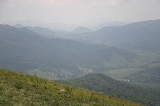
Wetlina
Encyclopedia
Wetlina w is a village with a population of 307 (in 2004) located in south-eastern Poland in the Subcarpathian Voivodeship
, near the border with Slovakia
. It is near the entrance to Bieszczady National Park
and is situated along the Wetlinka river.
Boykos montagnards were the primary inhabitants of the area until 1945. Following battles between the Ukrainian Insurgent Army and the Peoples' Army of Poland, the area was completely depopulated. It was resettled during the 1950s and 1960s with forestry workers and Franciscan
Friars.
On June 7, 1946, the Polish Army entered the village under operation named "Vistula." "Operation Vistula" was set forth to purge partisans from the region. The partisans had been living in the forests and mountains, and continued to harass and agitate the Poland authorities in their fight for political autonomy. It was believed that the villagers were supporting the partisans with food and supplies. The Poland Army gave the residents one hour to pack up their belongings, loaded them on trucks and deported ("resettled") the residents to distant villages in northern Poland and Ukraine. The Army set fire to all the citizens remaining possessions, including houses, barns and haystacks. They wanted nothing to remain for the partisans. Several citizens died in the deportation and only two or three families from the village were allowed to resettle in the same place. No one was allowed to resettle in the area until 1958, at which time, the Poland government only allowed ethnic Polish to settle in the region.
The foundations of the largest Cerkiew (Eastern Rite Church), Church of Christ the King (Greek Catholic) in the area is found in the village. The church was destroyed by fire in 1946 and the foundation dynamited by the Polish Army in 1950. Adjacent to the ruins, the Miłosierdzia Bożego Roman Catholic Church
was built in the early 1980s.
 Wetlina is shares in the tourism of the Bieszczady Mountain
Wetlina is shares in the tourism of the Bieszczady Mountain
area. Trips to L'viv, festivals, and hiking are popular activities.
Subcarpathian Voivodeship
Podkarpackie Voivodeship , or Subcarpathian Voivodeship, is a voivodeship, or province, in extreme-southeastern Poland. Its administrative capital and largest city is Rzeszów...
, near the border with Slovakia
Slovakia
The Slovak Republic is a landlocked state in Central Europe. It has a population of over five million and an area of about . Slovakia is bordered by the Czech Republic and Austria to the west, Poland to the north, Ukraine to the east and Hungary to the south...
. It is near the entrance to Bieszczady National Park
Bieszczady National Park
Bieszczady National Park is the third largest National Park in Poland, located in Subcarpathian Voivodeship in the extreme south-east corner of the country, bordering Slovakia and Ukraine....
and is situated along the Wetlinka river.
History
Vetlyna was first mentioned as a populated village in the year 1580, organized under Wallachian Law. In 1880 there were 115 homes listed in the local census. The majority of the population ascribed to the Greek Catholic faith.Boykos montagnards were the primary inhabitants of the area until 1945. Following battles between the Ukrainian Insurgent Army and the Peoples' Army of Poland, the area was completely depopulated. It was resettled during the 1950s and 1960s with forestry workers and Franciscan
Franciscan
Most Franciscans are members of Roman Catholic religious orders founded by Saint Francis of Assisi. Besides Roman Catholic communities, there are also Old Catholic, Anglican, Lutheran, ecumenical and Non-denominational Franciscan communities....
Friars.
On June 7, 1946, the Polish Army entered the village under operation named "Vistula." "Operation Vistula" was set forth to purge partisans from the region. The partisans had been living in the forests and mountains, and continued to harass and agitate the Poland authorities in their fight for political autonomy. It was believed that the villagers were supporting the partisans with food and supplies. The Poland Army gave the residents one hour to pack up their belongings, loaded them on trucks and deported ("resettled") the residents to distant villages in northern Poland and Ukraine. The Army set fire to all the citizens remaining possessions, including houses, barns and haystacks. They wanted nothing to remain for the partisans. Several citizens died in the deportation and only two or three families from the village were allowed to resettle in the same place. No one was allowed to resettle in the area until 1958, at which time, the Poland government only allowed ethnic Polish to settle in the region.
The foundations of the largest Cerkiew (Eastern Rite Church), Church of Christ the King (Greek Catholic) in the area is found in the village. The church was destroyed by fire in 1946 and the foundation dynamited by the Polish Army in 1950. Adjacent to the ruins, the Miłosierdzia Bożego Roman Catholic Church
Roman Catholic Church
The Catholic Church, also known as the Roman Catholic Church, is the world's largest Christian church, with over a billion members. Led by the Pope, it defines its mission as spreading the gospel of Jesus Christ, administering the sacraments and exercising charity...
was built in the early 1980s.
Population
The population of the area and the village for the years 1881-2004 is listed below.| Year | Population |
|---|---|
| 1735 | 639 |
| 1881 | 819 |
| 1921 | 805 |
| 1938 | 1037 |
| 1947 | 0 |
| 1991 | 296 |
| 2004 | 307 |
Geography and Location
The village is located near the source (springs) of the Weltinka river, a primary tributary of the Solinka river. South and west of the village are the Sękowa (1022 m) and Paprotna (1193 m) mountain peaks. East of the village are the range peaks of Połonina Wetlińska, with a maximum elevation of 1253 m.Tourism

Bieszczady Mountains
Bieszczady is the Polish name for a mountain range in the extreme south-east of Poland, extending into Ukraine and Slovakia...
area. Trips to L'viv, festivals, and hiking are popular activities.

